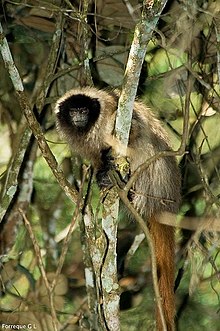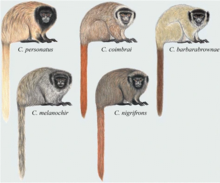| Callicebus | |
|---|---|

| |
| Atlantic titi (Callicebus personatus) | |
| Scientific classification | |
| Domain: | Eukaryota |
| Kingdom: | Animalia |
| Phylum: | Chordata |
| Class: | Mammalia |
| Order: | Primates |
| Suborder: | Haplorhini |
| Infraorder: | Simiiformes |
| Family: | Pitheciidae |
| Subfamily: | Callicebinae |
| Genus: | Callicebus Thomas, 1903 |
| Type species | |
| Simia personatus É. Geoffroy, 1812
| |
| Species | |
|
Callicebus barbarabrownae | |
Callicebus is a genus of monkeys known as titi monkeys.
Historically, titis were monogeneric, comprising only the genus Callicebus Thomas, 1903. Owing to the great diversity found across titi monkey species, a new genus-level taxonomy was recently proposed that recognises three genera within the subfamily Callicebinae; Cheracebus Byrne et al., 2016 for the species of the torquatus group (Widow titis); Plecturocebus Byrne et al., 2016 for the Amazonian and Chaco titis of the moloch and donacophilus groups; and Callicebus Thomas, 1903 sensu stricto, for species of the Atlantic Forest personatus group.[1]
In 2014, a previously unknown orange Callicebus was spotted in the Peruvian Amazon; it has not been determined whether this constitutes a color variant or a new species.[2]
Species
[edit]There are 5 species in this genus:
- Barbara Brown's titi monkey, Callicebus barbarabrownae
- Coimbra Filho's titi monkey, Callicebus coimbrai
- Coastal black-handed titi monkey, Callicebus melanochir
- Black-fronted titi monkey, Callicebus nigrifrons
- Atlantic titi monkey, Callicebus personatus

References
[edit]- ^ Byrne, Hazel; Rylands, Anthony B.; Carneiro, Jeferson C.; Alfaro, Jessica W. Lynch; Bertuol, Fabricio; da Silva, Maria N. F.; Messias, Mariluce; Groves, Colin P.; Mittermeier, Russell A. (2016-01-01). "Phylogenetic relationships of the New World titi monkeys (Callicebus): first appraisal of taxonomy based on molecular evidence". Frontiers in Zoology. 13: 10. doi:10.1186/s12983-016-0142-4. ISSN 1742-9994. PMC 4774130. PMID 26937245.
- ^ Vriesendorp, Corine (27 March 2015). "Possible New Primate Discovered in Peru". Field Museum of Natural History. Retrieved 6 February 2022.




Well, that’s interesting to know that Psilotum nudum are known as whisk ferns. Psilotum nudum is the commoner species of the two. While the P. flaccidum is a rare species and is found in the tropical islands. Both the species are usually epiphytic in habit and grow upon tree ferns. These species may also be terrestrial and grow in humus or in the crevices of the rocks.
View the detailed Guide of Psilotum nudum: Detailed Study Of Psilotum Nudum (Whisk Fern), Classification, Anatomy, Reproduction